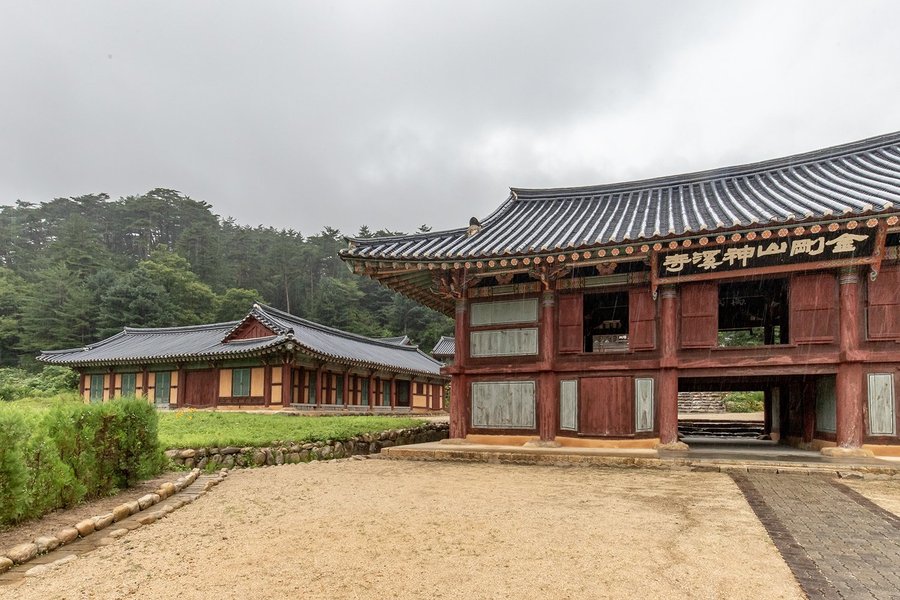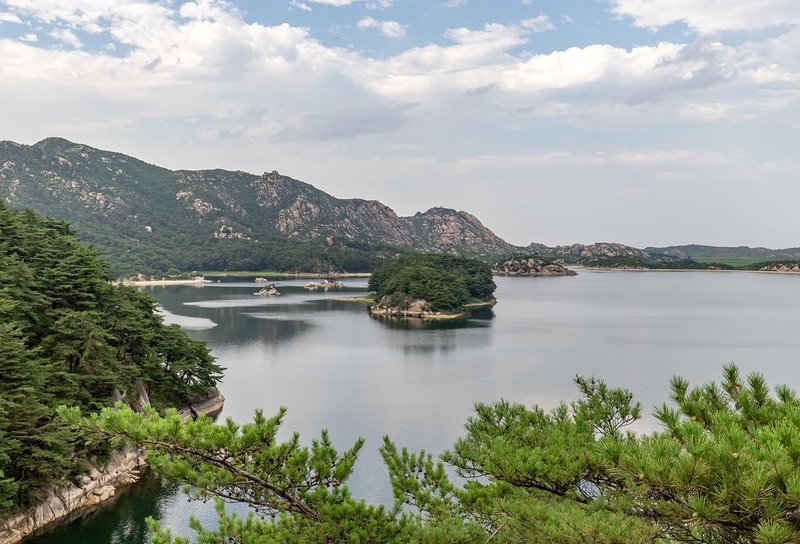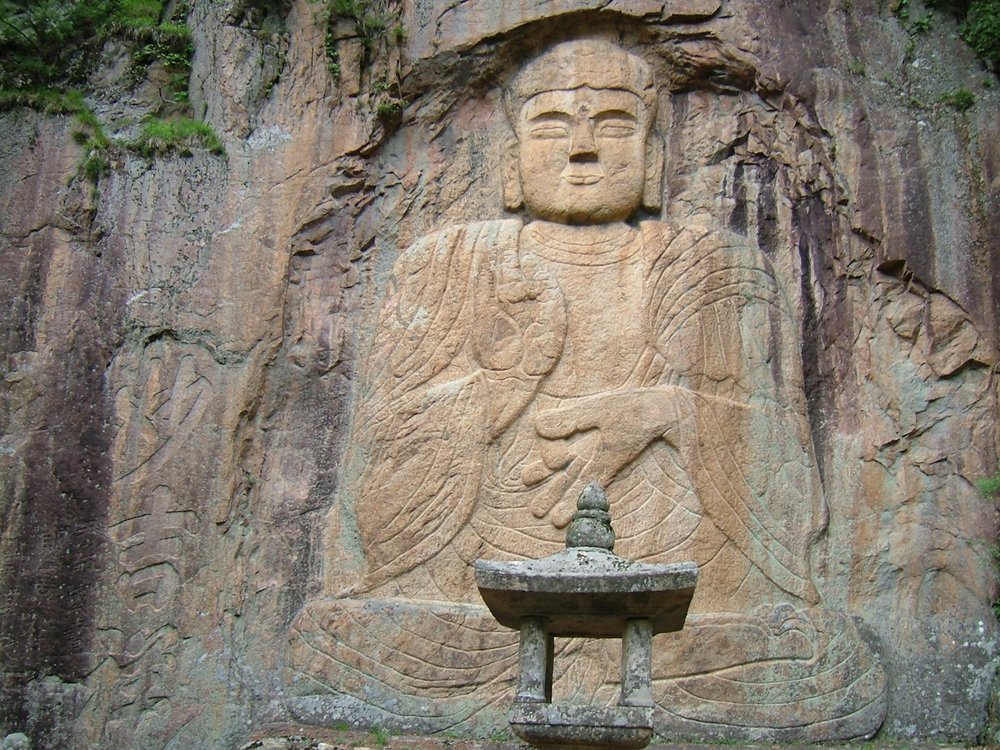Korea (DPR)
Mount Kumgang
Mount Kumgang – Diamond Mountain from the Sea stands for a beautiful mountain landscape with different landforms, which is also considered a sacred mountain.
The Outer Kumgang and Inner Kumgang Area holds granite peaks, waterfalls, ponds and has attracted artists and pilgrims for generations. The rocks are decorated with Buddhist sculptures to make the mountain more beautiful. Also, the uninterrupted vistas to the nearby coastline are special.
Community Perspective: Christravelblog visited the area in summer 2019.
Site Info
Official Information
- Full Name
- Mount Kumgang – Diamond Mountain from the Sea (ID: 1642)
- Country
- Korea (DPR)
- Status
-
Inscribed 2025
Site history
History of Mount Kumgang
- 2025: Inscribed
- Meets criterion 3 and 7 for 2 of the 4 proposed components
- 2024: Postponed
- "could not be undertaken following the request of the State Party due to the COVID-19 situation in the country."
- 2023: Postponed
- "submitted in 2021, could not be undertaken following the request of the State Party due to the COVID-19 situation in the country"
- 2021: Incomplete - not examined
- 2019: Preparatory Assistance
- 2018: Upstream Process
- 2000: Added to Tentative List
- Added to tentative list
- WHS Type
- Mixed
- Criteria
- iii
- vii
Links
- UNESCO
- whc.unesco.org
All Links
UNESCO.org
- whc.unesco.org — whc.unesco.org
Community Information
- Community Category
- Natural landscape: Mountain
- Cultural Landscape: Associative
Travel Information
Guided Tour Only
Recent Connections
-
Poetic Quotations
"This area is also the place where Yang… -
Literature
"The landscape setting of steep granite… -
Named after a Mountain
"Mount Kumgang (or "Diamond Mountain") …
Connections of Mount Kumgang
- Individual People
-
-
Isabella Bird
Bird is believed to have coined (or popularized) the phrase Diamond Mountain "From the spirit shrine on the summit a lovely panorama unfolds itself, billows of hilly woodland, gleams of water, wavy outlines of hills, backed by a jagged mountain wall, attaining an altitude of over 6,000 feet in the loftiest pinnacle of the Keum-Kang San. A fair land of promise, truly! But this pass is a rubicon to him who seeks the Diamond Mountain with the intention of immuring himself for life in one of its many monasteries. A description can be only a catalogue. The actuality was intoxicating, a canyon on the grandest scale, with every element of beauty present. Towards evening "The hills swung open to the light"; through the parting branches there were glimpses of granite walls and peaks reddening into glory; red stems, glowing in the slant sunbeams, lighted up the blue gloom of the coniferæ; there were glints of foam from the loud-tongued torrent below; the dew fell heavily, laden with aromatic odors of pines, and as the valley narrowed again and the blue shadows fell the picture was as fair as one could hope to see. On that enchanting May evening, when odors of paradise, the fragrant breath of a million flowering shrubs and trailers, of bursting buds, and unfolding ferns, rose into the cool dewy air, and the silence could be felt, I was not inclined to enter a protest against Korean exaggeration on the ground that the number of peaks is probably nearer 1,200 than 12,000." - published in 'Korea and her Neighbours', a narrative of travel, with an account of the vicissitudes and position of the country Chapter 11 Diamond Mountain Monasteries Pg. 133 - 149 -
Homer B. Hulbert
"The most famous monasteries in Korea are those in Diamond Mountain, a cluster of peaks near the central eastern part of the peninsula. They are celebrated even in China, and thousands of pilgrims have sought for merit by dragging their weary limbs all the way to this holy place. Several flourishing monasteries are passed on the way up the steep valley, for here, if nowhere else, Buddhism seems to have some show of vitality left." "The Passing of Korea" pg. 292-293
-
- Geography
-
-
Sea of Japan
"Uninterrupted vistas from Mt. Kumgang's ridgetops to the coastline attest to the intimate relationship of the property to the sea." - IUCN Evaluation
-
- Trivia
-
-
On Banknotes
5 Won - 1978. Mount Gumgang; 1 Won - 1992. Mount Gumgang
-
- History
-
-
Women Explorers
Isabella Bird claimed to be the first European Women to visit Mount Kumgang during her extensive visit in 1894 and is believed to have coined the term 'Diamond Mountain'. She visited the Four Great Temples of Mount Kumgang during a multi-day journey. "The first European woman to visit the Keum-Kang San being regarded as a great sight and from early morning till late at night there was no rest." - published in 'Korea and her Neighbours', a narrative of travel, with an account of the vicissitudes and position of the country Chapter 11 Diamond Mountain Monasteries Pg. 133 - 149 -
Fusion
"Many of the historic sites, scenic spots and stone calligraphy also reflect a fusion of Buddhism with Taoism and local indigenous beliefs. Mount Kumgang is an associative cultural landscape where there is a complex and intertwined relationship between the distinctive landforms and scenery, and the long history of Buddhism, pilgrimage and traditions of mountain worship in the Korean peninsula." - AB Evaluation -
Three Kingdoms of Korea
Of the 'Four Great Temples of Mount Kumgang' 3 were founded by Silla, one under Goguryeo "The temples within the nominated property were established in the 6th and 7th century CE, namely the Phyohun Temple (670), Jongyang Temple (600), Singye Temple (519), Podok Hermitage (627) and Pulji Hermitage (666)." - AB Evaluation
-
- Ecology
-
-
Granite rock formations
"The landscape setting of steep granite peaks, rock formations, waterfalls and pools are integral to the long traditions of Buddhist pilgrimage, and the many famed literary and artistic representations of Mount Kumgang." - AB Evaluation -
Lagoons
"Although there are relatively few potential attributes in component part 002 (Samil Lagoon), historical texts indicate that the area has been a popular place for Buddhist practices, and the Mongchon hermitage site has functional links to the Buddhist sites in component part 001." - AB Evaluation -
Bird Migrations
"Parts of the nominated property also play an important role as part of the East Asian-Australasian Flyway for migratory shorebirds." - IUCN Evaluation
-
- Architecture
-
-
Rock Cut Architecture
"The 14th century Myogilsang and Sambul Rock feature some of the largest Buddha sculptures in the Korean Peninsula." - AB EvaluationSee en.wikipedia.org
-
Wooden architecture
"Wooden structures such as the Phyohun Temple, Jongyang Temple, Podok Hermitage, Pulji Hermitage, and Chilsong Shrine of Mahayon Buddhist School site exhibit a high degree of authenticity in relation to the proposed Outstanding Universal Value." - AB Evaluation
-
- Damaged
-
-
Damaged in War since WWII
"During the Korean War (1950-1953) many Buddhist temples and hermitages were lost or severely damaged." - AB Evaluation
-
- World Heritage Process
-
-
Upstream process
2018 -
Mixed and Cultural Landscape
Associative CL "Mount Kumgang is an associative cultural landscape where there is a complex and intertwined relationship between the distinctive landforms and scenery, and the long history of Buddhism, pilgrimage and traditions of mountain worship in the Korean peninsula." - AB Evaluation -
Postponed sites
In 2023 and 2024, as no mission was allowed into the DPRK due to the COVID situation -
Potential Transboundary sites
Seoraksan National Park (Republic of Korea)
-
- Religion and Belief
-
-
Legends and Folk Myths
Numerous tales about "Tigers of the Kumgang Mountains" "Mount Kumgang is a place associated with mountain legends and fairy tales, folk songs, poems, and drawings, including works of many famous writers and artists." - AB Evaluation -
Pagoda
"Uninterrupted vistas from Mt. Kumgang's ridgetops to the coastline attest to the intimate relationship of the property to the sea." - IUCN EvaluationSee en.wikipedia.org
-
Taoism
"Some of the cultural heritage attributes also contain evidence of the intermingling of Buddhism with Taoism and local spirituality, such as mountain gods, the Great Bear, and wild animals." - AB Evaluation -
Sacred Mountains
"In addition to its scenic beauty, Mount Kumgang is considered to be an important sacred mountain within the Buddhist world." - AB Evaluation
-
- Human Activity
-
-
Honey Collection
"Although some traditional land use practices are briefly mentioned (such as agriculture, honey collection, medicinal herbs and mineral water), ICOMOS does not consider that this is represented within the nominated property in an exceptional way." - AB Evaluation - Account of Isabella Bird 1894 "There I had to eat a second ethereal meal, and the hospitable hostess forced on me a pot of exquisite honey and a bag of pine nuts. The honey is also locally produced. The beehives, which usually stand two together in cavities in the rocks." - published in 'Korea and her Neighbours', a narrative of travel, with an account of the vicissitudes and position of the country Chapter 11 Diamond Mountain Monasteries Pg. 133 - 149
-
- Constructions
-
-
Stelae
"The stele and stupa of Sosan, a key figure in the history of Korean Buddhism from the 17th century is also found within the nominated property." - AB Evaluation
-
- WHS on Other Lists
-
-
World Biosphere Reserves
"Mount Kumgang was designated as a UNESCO Biosphere Reserve in 2018." - AB Evaluation
-
- Timeline
-
-
Cretaceous
"The underlying geology of Mt. Kumgang is dominated by the Mesozoic Cretaceous Kumgansan granite batholith (92-112 million years old)." - IUCN Evaluation -
Built in the 6th century
"The nominated property includes Buddhist temples and hermitage sites dating from the 6th to the 20th century." - AB Evaluation
-
- Visiting conditions
-
-
Guided Tour Only
"All visits to the site are guided and strictly controlled." - IUCN Evaluation "All visitors must be accompanied by guides, including Buddhists who visit for religious purposes. The maximum number of tourists in a tour group is fifty. The tour guides are responsible for the safety of the visitors and for the provision of information." - AB Evaluation
-
- WHS Names
-
-
Named after a Mountain
"Mount Kumgang (or "Diamond Mountain") is a mountainous landscape which is nominated for its cultural and natural heritage values." - AB Evaluation
-
- Literature & Film
-
-
Literature
"The landscape setting of steep granite peaks, rock formations, waterfalls and pools are integral to the long traditions of Buddhist pilgrimage, and the many famed literary and artistic representations of Mount Kumgang. The intangible cultural heritage of this landscape is further reflected in the naming of key features, poems and folk tales." - AB Evaluation -
Poetic Quotations
"This area is also the place where Yang Sa On (1517-1584), one of the three most famous calligraphers of the Korean Peninsula, practised his calligraphy. He left his poem praising the beauty of Samil Lagoon carved on the rock next to the place where he practised his calligraphy." - AB Evaluation "He was fond of landscapes of a Taoist mood like Geumgangsan Mountain and loathed mundane constraints."
-
News
No news.
Community Reviews
Show full reviews
Mount Kumgang is not an easy WHS to visit as it's located in the very closed country of North Korea. I visited in summer 2019 on a rainy day. Quite happy I did, as since 2020 North Korea is kind of closed for tourists completely. It was my second time in North Korea, again on a private itinerary (with my son this time though). Of course, 2 guides and a driver joined, but no group tour as I had specific wishes to see places. Things are possible. Mount Kumgang is not on many itineraries, and I didn't see a single other tourist throughout that day trip from Wonsan. The nomination file says the area can receive up to 1300 tourist with an average of 700 normally. Not sure about that; probably North Korean numbers.
The first stop was at Lagoon Samil Area in Sea Kumgang, which, at that time I didn't know, is part of the core zone as well. It's a beautiful lagoon with tiny islands and some shrines. Very peaceful. We stopped at a couple of lookout points and walked along the wooden walkways along the shore. It wasn't raining (yet).

Looking at the current WHS maps with inscribed area, I did not visit the area at the actual sea. It was offlimits probably due to sensitive area. I did ask at that time about Sea Kumgang, and the guides said I will see it. I think they simply meant the Lagoon Samil, which is part of it. …
Keep reading 0 comments
